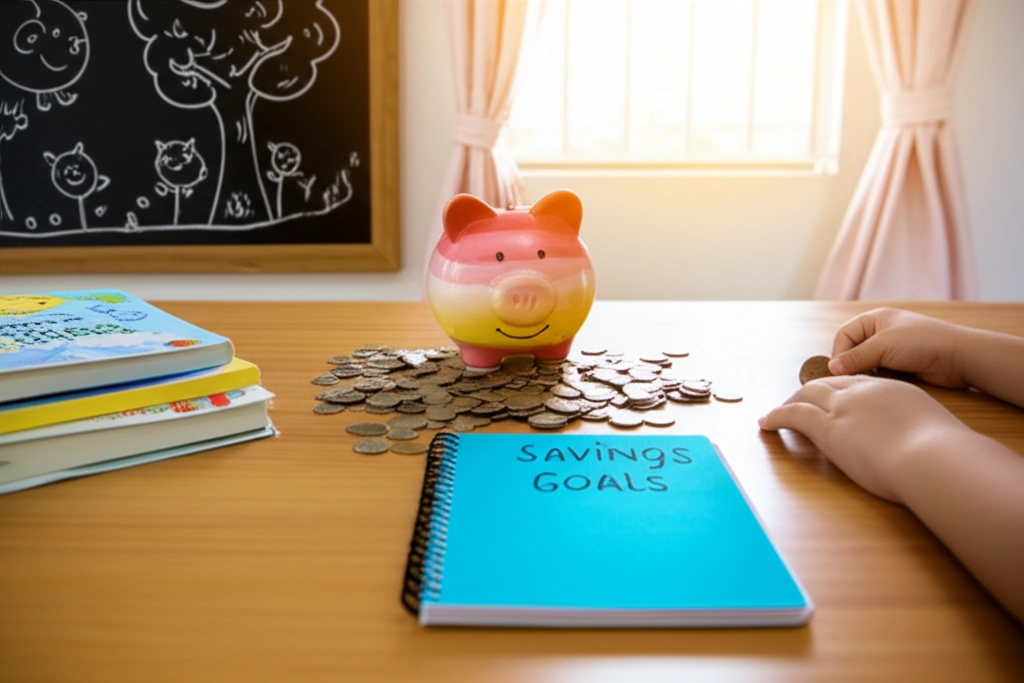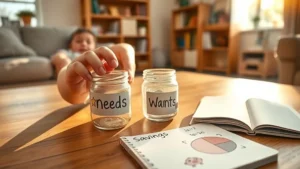Ever watched a kid eye a shiny new toy, already counting out crumpled bills and coins? There’s a magic in that moment—not just the toy, but the spark of learning how powerful saving money can really be. If you’re thinking, “Is teaching kids to save actually that important?” buckle in. You’re about to see exactly why it’s one of the best gifts you can give a child—even if that piggy bank only rattles with nickels and dreams right now.
I know, talking about money with kids can feel awkward, maybe even a little overwhelming. But here’s the thing: fostering good saving habits in childhood is like handing your kids a map long before they ever wander the wilds of grown-up finances. The rewards? Way beyond what you might expect. Let’s dive into the “10 benefits of saving money for kids”—straight answers, honest risks, and the simple, joyful stuff that builds savvy, confident adults.
Why It Matters
Okay, friend, here’s the heart of it: Kids who learn to save aren’t just stashing cash—they’re building mindsets and skills that can save them from a world of stress and trouble later on. It’s like teaching them to tie their shoes; clumsy at first, but soon it’s second nature. And in a world where one missed paycheck can send many adults into a panic, financial confidence is more than just “nice to have”—it’s vital. According to financial educators, those early saving lessons have ripple effects that shape a lifetime of choices.
Still, it’s not about making your seven-year-old obsessed with their bank balance. The importance of saving money is as much about enjoying simple victories—like finally buying that LEGO set with allowance money—as it is about avoiding messy traps like debt or impulsive overspending. We’ll celebrate both sides here, give you real talk, and keep it practical.
Benefits And Balancing Acts
Let’s be real. There are risks if you overdo it. Too much focus on money—even with good intentions—can sometimes backfire, making kids anxious or too attached to “stuff.” That’s why the smart money is on balance: Goal-setting, encouragement, and a little real-world responsibility, all wrapped up in love. Punishing or bribing with cash? Nah, that’s old news. Pair saving with guidance, and you’re setting your kid up for way more than a full piggy bank.
The 10 Benefits Of Saving Money For Kids
Ready for the good stuff? Here’s what the experts and real families say really happens when kids start saving early:
1. Delayed Gratification & Goal Setting
Ever waited weeks for something you really wanted? It’s tough! But that very process—saving for a skateboard, a tablet, or even a trip—teaches kids the joy of working toward a goal. It’s delayed gratification in action, and trust me, it changes how they see every future purchase. Next time you set up a “goal jar” with your child, you’re sneakily building grit and patience along with dollars. Parents tell me their kids’ faces practically glow at the end of a weeks-long saving streak. It’s the sweetest kind of pride—and it sticks around.
2. Building Financial Literacy Early
Kids who save aren’t just collecting coins—they’re learning the ABCs of money itself. Where does money come from? How does change work? What does “interest” mean on a bank account? Each question opens a door into the world of financial literacy, and hands-on saving is one of the best teachers. I still remember my little cousin proudly explaining “how banks work” after depositing her birthday money. Sneak in lessons at the grocery store, use games, or try storytelling—and the learning feels natural, not forced. For more real-world examples, check out resources highlighted by Bankaroo.
3. Fostering Independence And Responsibility
You wouldn’t want your kids leaning on you for pocket money forever, right? Saving helps them step up and own their choices. When a child buys something with their own hard-saved cash, there’s this “aha!” moment of independence—and sometimes, true awareness of what that item is really worth. They start weighing if the new game is as cool as they imagined…or if saving a little more for something else is better. That’s responsibility in action, and it’s the root of so many good decisions down the road. There’s genuine pride in saying, “I bought this myself.”
4. Creating An Emergency Cushion (And Avoiding Debt)
Life loves to throw curveballs—even at kids. Maybe their favorite toy breaks, or they want to help chip in for a class trip last-minute. If they’ve saved up, there’s a little comfort blanket in their back pocket. This isn’t about scaring them, but gently showing the value of having a tiny “just in case” fund. Parents, you can sweeten the lesson: maybe match their emergency savings for added motivation. And the big bonus? They’ll understand early on why running up debt (even if it’s “just borrowing from Mom”) isn’t a great long-term plan. According to financial experts, this is the foundation of avoiding grown-up financial stress later.
5. Budgeting And Smarter Choices
Ever watched a kid in the candy aisle with a $5 bill, torn between five different sweets and a comic? Welcome to budgeting, kid-style. “Needs vs. wants” becomes real when it’s their own money on the line. This skill, learned in low-stakes moments, translates to adult life with bigger consequences. Try making shopping a “budget game”—let them pick a few must-haves and a couple of wish-list items. The conversations that follow are golden. For more tips and relatable stories, don’t miss what are 5 benefits of saving money, an excellent guide for anyone looking to dig deeper.
6. Growing Confidence And Healthy Money Habits
There’s just something powerful about watching your own savings pile up. Confidence blooms as kids see their jars and accounts grow. The bigger lesson? They can do hard things, and the results are tangible. I’ve seen even stubborn kids get the money-saving bug after their “first big buy” from their own pocket. Down the line, these habits stick—and turn into less stress, healthier bank accounts, and, often, a well-deserved feeling of control over their financial life.
7. Planning For Big Dreams
Some goals take months, even years—saving for a camp, a bike, or for older kids, future college needs. Learning early that big dreams are possible with steady effort is a huge life lesson. Parents, this is your chance to talk about options: savings accounts for kids, custodial accounts, or even special “goal jars.” And as those numbers steadily tick upward, you’ll have countless moments to celebrate together. For more insight into setting up student and long-term accounts, you might enjoy reading 10 benefits of saving money for students essay.
8. Learning About Interest And Even Basic Investing
Here’s where it gets cool: After the piggy bank comes the bank account. Show a child how $10 can become $10.10 on its own, thanks to interest, and watch those lightbulbs go off! Older kids might be ready for basic lessons about investments, like “What if we buy one stock?” It’s not about making them the next Warren Buffett—it’s about showing them that money is a tool, a partner, and sometimes it works even while we sleep. Keep it simple, keep it fun, and the curiosity will do the rest.
9. Reducing Anxiety & Building Resilience
Money stress isn’t just for adults. Kids notice when the adults in their life are worried about bills or shortages, even if it’s unspoken. Having their own little nest egg—however modest—can actually help kids feel safer and more secure. It nurtures a sense of possibility. And over time, these little moments of financial confidence stack up, leading to adults who approach money from a place of calm, not fear. A study from MyMoneyCoach echoes this: early savings habits can lead to less financial stress and more positive attitudes later in life.
10. Strengthening Family Bonds Through Money Talks
Maybe the most unexpected benefit of all? Saving together is a family affair. When parents and kids chat about goals, celebrate milestones, or even share in budget fails (oh, we’ve all got stories), you’re building trust and openness. You’re modeling values—showing that money is just a tool, not a taboo or a source of shame. Some families hold “family savings meetings,” others offer matching contributions for big goals. However you do it, you’ll find that saving together isn’t just about the dollars, but about creating memories and honest conversations that last.
If you want more perspectives from both parents and financial advisors on how to make this a joyful team effort, dive into 10 benefits of saving money essay.
How To Save: Making It Work For Any Age
Okay, so you’re on board—but now you’re wondering, “What does saving actually look like for a five-year-old versus a twelve-year-old?” You’ve got options! For little ones, keeping things visible and tangible—like labeled jars or sticker charts—works wonders. Kids aged 8–12? Let them manage allowance in a simple account or start setting mini-goals tied to chores. If you’ve got teens, consider a joint or custodial account, even introducing CDs or a first look at investing (together, with guidance!). Break it down; keep it age-appropriate and fun.
Want fresh ideas for getting started, from toddlers to teens? Here’s a fantastic, practical resource: 3 reasons to save money. If you see their eyes light up at a new game or gadget, use that excitement as your springboard!
Creating A Supportive Environment
Look, no system is perfect. Some kids will get discouraged, or maybe even try to “borrow” from their piggy banks when temptation strikes. Don’t sweat it—mistakes are just another form of learning. Consider matching their savings for a big goal, or create family rituals around “interest earned” every month. It’s about starting, not perfection.
One family I know celebrates “Savings Day” once a month—everyone in the house, from toddlers to grandparents, counts up their savings and shares one thing they’re working toward. There’s a lot of laughter, sometimes a little friendly competition, and always a sense of pride that’s impossible to fake. If you’re feeling stuck, try bringing the whole crew together and making saving a true team sport.
Quick Steps To Get Started
- Pick a goal together. Ask your child what they want and talk about what it might take to get there.
- Choose your saving method—a clear jar, a simple spreadsheet, or an online kids’ account.
- Make tracking a weekly routine, not a chore. Celebrate tiny wins!
- Offer small rewards for reaching milestones—but keep the focus on the fun of progress.
- Tell stories about your own wins (and fails!) with money. They’ll remember the honesty.
- Check in and adjust! If saving becomes stressful, hit pause, and laugh about it. Money truths are best learned with love, not pressure.
Wrapping Up: Small Savings, Big Future
There’s something quietly heroic about a kid who knows how to save—even if that means picking the $3 toy today instead of begging for the $30 one. When you lean in and share these lessons, you’re not just teaching about money, but giving your kids tools for confidence, independence, and a lifetime of opportunity. Start small; keep it playful. Remember, every $1 set aside opens the door to a bigger world of choices, stability, and yes, even joy.
Curious about other ways kids and students can benefit? Read more about the 10 benefits of saving money for students essay for fresh tips and stories. If you’ve tried any of these strategies or have your own family saving tradition, don’t keep it a secret—share it with other parents who might just need that gentle nudge, too. Your next great memory (and maybe your child’s next big dream) could start with a single saved coin.









